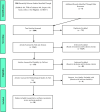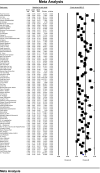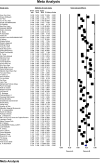The global prevalence of osteoporosis in the world: a comprehensive systematic review and meta-analysis
- PMID: 34657598
- PMCID: PMC8522202
- DOI: 10.1186/s13018-021-02772-0
The global prevalence of osteoporosis in the world: a comprehensive systematic review and meta-analysis
Abstract
Background: Osteoporosis affects all sections of society, including families with people affected by osteoporosis, government agencies and medical institutes in various fields. For example, it involves the patient and his/her family members, and government agencies in terms of the cost of treatment and medical care. Providing a comprehensive picture of the prevalence of osteoporosis globally is important for health policymakers to make appropriate decisions. Therefore, this study was conducted to investigate the prevalence of osteoporosis worldwide.
Methods: A systematic review and meta-analysis were conducted in accordance with the PRISMA criteria. The PubMed, Science Direct, Web of Science, Scopus, Magiran, and Google Scholar databases were searched with no lower time limit up till 26 August 2020. The heterogeneity of the studies was measured using the I2 test, and the publication bias was assessed by the Begg and Mazumdar's test at the significance level of 0.1.
Results: After following the systematic review processes, 86 studies were selected for meta-analysis. The sample size of the study was 103,334,579 people in the age range of 15-105 years. Using meta-analysis, the prevalence of osteoporosis in the world was reported to be 18.3 (95% CI 16.2-20.7). Based on 70 studies and sample size of 800,457 women, and heterogenicity I2: 99.8, the prevalence of osteoporosis in women of the world was reported to be 23.1 (95% CI 19.8-26.9), while the prevalence of osteoporosis among men of the world was found to be 11.7 (95% CI 9.6-14.1 which was based on 40 studies and sample size of 453,964 men.). The highest prevalence of osteoporosis was reported in Africa with 39.5% (95% CI 22.3-59.7) and a sample size of 2989 people with the age range 18-95 years.
Conclusion: According to the medical, economic, and social burden of osteoporosis, providing a robust and comprehensive estimate of the prevalence of osteoporosis in the world can facilitate decisions in health system planning and policymaking, including an overview of the current and outlook for the future; provide the necessary facilities for the treatment of people with osteoporosis; reduce the severe risks that lead to death by preventing fractures; and, finally, monitor the overall state of osteoporosis in the world. This study is the first to report a structured review and meta-analysis of the prevalence of osteoporosis worldwide.
Keywords: Meta-analysis; Osteoporosis; Prevalence; Systematic review.
© 2021. The Author(s).
Conflict of interest statement
The authors declare that they have no conflict of interest.
Figures








References
-
- Mohammed ZA, Almeshal MA, Aldawsari SA, Alanazi MA, Alanazi AD, Alqahtani FA, et al. Prevalence of fracture and osteoporosis and awareness of osteoporosis among general population of Majmaah City IN 2018. Indo Am J Pharmaceut Sci. 2019;6(1):357–361.
-
- Aoki TT, Grecu EO, Srinivas PR, Prescott P, Benbarka M, Arcangeli MM. Prevalence of osteoporosis in women: variation with skeletal site of measurement of bone mineral density. Endocr Pract Off J Am Coll Endocrinol Am Assoc Clin Endocrinol. 2000;6(2):127–131. - PubMed
-
- Askari M, Lotfi MH, Owlia MB, Fallahzadeh H, Mohammadi M. Survey of osteoporosis risk factors (review article) J Sabzevar Univ Med Sci. 2019;25(6):854–863.
Publication types
MeSH terms
Grants and funding
LinkOut - more resources
Full Text Sources
Medical

